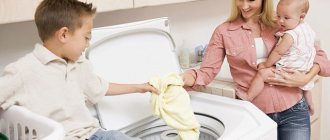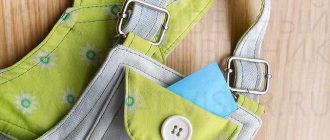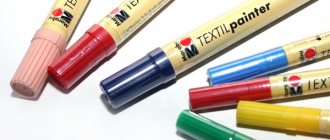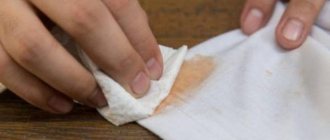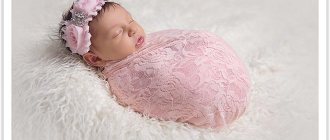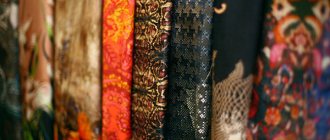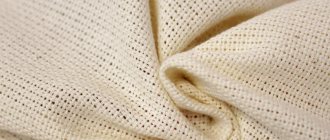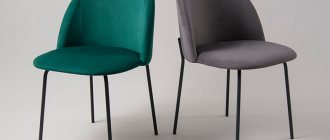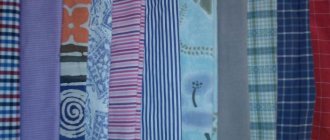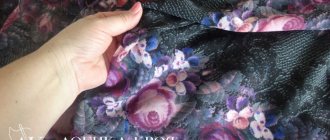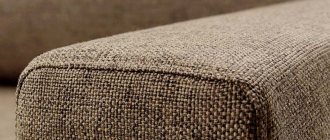What's most important?
When choosing fabric for children, you need to find fault even with the little things, because... The skin of babies, and especially babies, is very delicate and sensitive. She is most susceptible to allergies and damage. This applies to all fabrics that the child comes into contact with, not only bedding and clothing, but also toys and diapers. If we are not textile specialists and cannot clearly determine which fabric is safe, we can use special labeling. Today, textile manufacturers accurately determine the properties of the fabrics they sell. Don't be fooled by the pretty design.
First, let's look at the signs. Fabric with Oeco-Tex certificate indicates that the material is safe for children and is natural and hypoallergenic. This is an international quality mark that will always help you in your choice.
New generation synthetics
Synthetic materials are considered not the best choice of fabric for children's clothing, but synthetics are different from synthetics. The modern textile industry creates synthetic fabrics with excellent characteristics.
- Microfiber is a synthetic fabric made of polyester or polyamide. It has absolutely all the characteristics of natural fabrics, but does not fade, does not fade, does not deform and has an antifungal effect. Children's robes, underwear, sweatshirts, pants, and thermal underwear are made from it.
- Fleece is a synthetic knitted fabric. This fabric is called artificial wool - it is lightweight, hypoallergenic, wear-resistant and breathable. Fleece wicks moisture away well and does not lose its thermal insulation properties when wet. It is used to make sweatshirts, pants, mittens, hats, blankets, and linings for outerwear. Today, when choosing a child's outerwear during the winter and off-season, parents increasingly prefer fleece.
Festive outfits are rarely made from fabrics classified as “children’s” - such clothes are intended for everyday wear and look quite simple. However, you should not strive to fill your baby’s wardrobe exclusively with 100% natural fabrics - children’s clothing for special occasions can also be made from mixed or synthetic fabrics (if the baby does not have allergies).
What fabric is most often chosen for children's clothes?
Currently, the most popular fabrics for sewing children's products are natural cotton, Minky fleece, linen and tetra. These fabrics are completely safe for baby's skin. Many parents know that allergic reactions on the child's skin caused by various materials are a fairly common problem. Therefore, fabric manufacturers pay special attention to children's materials and conduct additional tests for the presence of heavy metals and allergenic dyes. Fabrics must be safe, soft and pleasant to the touch.
Design
It is important to think about the style of the future outfit. A well-tailored dress will fit, following the contour of the figure, but at the same time, the fabric should not restrict movement. Usually this is a cut-off dress of the “Tatyanochka” type with a high waist and a full skirt. Despite the popularity of this model, each is beautiful in its own way, thanks to decorative elements, details, and decorations. Don’t be afraid to show your imagination, because it’s easier to please a little princess than an adult.
What should you pay attention to when choosing a product for a child?
Safe, certified fabrics are the basis. If we are confident that the proposed material meets these criteria, it is time to select a suitable pattern.
Things for children, clothes, bedding, curtains, carpets, blankets should be filled with color and fabulous designs. The children's world is a different world from the thoughtful world of adults. A child's world should be fabulous and colorful. Bears on the pillow, elephants on the blanket and hearts on the clothes. All this allows the child’s imagination to develop and create new and interesting worlds for his games.
When choosing fabrics for children, you shouldn’t think about how they will fit together or how many years these curtains will last. This is a children's world where everything beautiful will find its admirer and help the child's abilities to develop more.
We must remember that children feel best when surrounded by many flowers, accompanied by many characters from fairy tales and kind, smiling animals. Of course there are limits. In the case of a children's space, bedding colors and their warm shades are better suited. In the combination of warm colors and bright toys, the child feels safe and comfortable.
Knitted fabrics
The most common fabric for children's clothing today is cotton jersey - it has all the advantages of cotton fabrics, has excellent stretch and is comfortable to wear. Knitted fabrics come in different types.
- Kulirka – thin knitwear made of 100% cotton. It stretches well in width and does not stretch in length. Kulirka is used when sewing underwear - vests, rompers, underwear.
- Interlock and ribana are denser knitted fabrics made from 100% cotton. They also stretch well in width and do not stretch in length. Ribana is looser in structure and more elastic than interlock. It is widely used for making cuffs and necklines for clothing. Interlock and ribana are used to make underwear, tracksuits, T-shirts, dresses, sweatshirts, pajamas, and hats.
- Footer is a fabric made of 100% cotton or cotton with the addition of wool fibers. This type of knitwear has a smooth front side and a terry back. Depending on the number of threads used in the manufacture of the fabric, footer can be “one thread”, “two threads” and “three threads”. Footer retains heat well; it is used to make tracksuits, sweatshirts, diapers and warm clothes for babies.
- Capitonium is a two- or three-layer knitted cotton fabric. It is soft, warm and looks quite voluminous. Warm sweatshirts, pants, dresses, clothes and accessories for newborn children - overalls, envelopes, bedding - are made from capitonium.
Advice
When choosing knitwear for a child, it is better to give preference to things with a small percentage of elastane. They will sit better and stretch less.
Hem
A wide-step seam is sewn along the top of the skirt to allow for frequent gathering. You can form folds of the same length and secure with needles. The width of the belt should match the width of the bottom of the bodice. Having connected both parts, sew a seam from the inside and finish it with bias tape.
The bottom of the hem is hemmed by hand, or by machine, or finished with bias tape in color.
All that remains is to sew on the zipper and the dress is ready.
How to make a paper pattern for a children's jacket
Let's look at the finished pattern of a jacket with a hood .
We offer a drawing that allows you to sew a product for a baby whose age is 1 year and height 92 cm . Please note that the paper blank we are studying is made on checkered paper. The size of each cell is 1 cm . Thus, you will be able to independently calculate the parameters you need by enlarging or reducing the drawing.
Algorithm for working on a pattern
- Print the paper blank in full size or enlarge it yourself on graph paper, observing the proportions.
- Taking into account the measurements taken from the child, check whether the workpiece is suitable for the width of the product, the length of the jacket and sleeves.
- If necessary, make changes to the drawing, adjusting it to children's sizes.
- Cut out a shelf blank from paper. In the drawing it is shown in pink.
- Cut out the base for the back. You will find it on the same drawing as the shelf. Only now work with a blue pattern.
- Cut out the remaining parts: sleeve, side and center of the hood.
You now have all the paper parts needed to create a baby jacket.
Children's clothing made from synthetic fabrics
Fleece
Fleece made from polyester is also popular among children's clothing manufacturers. Textiles are not able to absorb moisture, but are distinguished by their lightness, strength and elasticity. Clothing made from this material does not require special care, and after washing it dries in a couple of hours.
Manufacturers of children's clothing actively use sheep wool, since such textiles are absolutely harmless to children. The fabric has water-repellent properties and also retains heat well. Children's clothing made from fabric does not require special care and is distinguished by its strength and durability.
When purchasing children's clothing, the final choice of textiles depends on the purpose for which the item is purchased and what time of year it will be worn. Knowing all the advantages and disadvantages of each type of fabric, you can choose the safest and highest quality material.
Designing a pattern for an elegant dress for a girl from a finished item
An item of suitable size should be ironed and the parts separated at the seams using tailor's scissors. Namely:
Front flap, back and one sleeve.
When transferring the outline to the fabric, it is important to take into account seam allowances. They are 1-2 centimeters. If a knitwear item is taken as a basis, then the appropriate fabric should be used.
When transferring the outline of a pattern for an elegant dress for a girl onto the material, it is better to pin its elements to the fabric with needles in several places. This way you can protect yourself from slipping and distortion.
The height of the shelf and back will depend on where you want the hem to be placed: at waist level, above or below. The sleeve can be made short, ¾, at wrist level.
The lower part of the outfit can be either gathered from a rectangular piece of fabric, where the shorter side is equal to the length of the hem, or flying, in the shape of a “sun”. The first option is the simplest and most economical, and the skirt of the dress will turn out to be fluffy, like a princess’s. The second is preferable for an older young lady, when, due to her height, the hem will fall in iridescent tails. Satin silk is the ideal fabric for creating a similar part of a long elegant dress for a girl.
The best natural fabrics for bed linen
Fabric for children's bedding must meet the following requirements:
- softness;
- hypoallergenic;
- hygroscopicity;
- breathability;
- wear resistance;
- calm colors of pleasant tones.
Note! The following natural materials meet these requirements: cotton, linen, bamboo.
Cotton
Cotton fabrics meet all the requirements, but have a number of disadvantages:
- creasing;
- shrinkage during washing;
- deformation due to frequent use.
The best types of cotton fiber material that can be used for bed linen are the following:
- Satin is a durable and dense material made from twisted cotton threads with a special satin weave. It has a smooth shiny surface that is very pleasant to the touch. The high density of the material provides good wear resistance for bed linen that is washed regularly. The colors do not fade and remain bright. Your baby will surely enjoy sleeping in a bed made with linens with 3D designs of cartoon characters. The smooth surface of satin bed linen will be comfortable even for a newborn.
- Calico is a cotton fabric made from plain weave threads. Less dense than satin, but still popular with buyers. It holds up well to multiple washes, but the colors lose a little brightness. Over time, pills may appear on the surface of the sheets, so for the youngest children it is better not to put calico linen in the crib.
- Ranfors is a very dense material made from a large number of twisted threads, which has excellent hygienic and temperature-regulating properties.
- Chintz is a cotton fabric of rare plain weave. The fabric is soft and smooth, but does not withstand washing well. Severely deformed and thinned. Satin and calico can compete only due to their low cost.
Cotton baby bedding
Linen
Typically, linen fabric is a little rough and hard to the touch. But modern manufacturers have learned to make it soft and pleasant to the body. It is from such processed flax that you can buy bumpers for a baby crib or a bedding set of sheets and duvet cover.
You might be interested in the importance of reinforced threads and fabrics in sewing
Pattern
At this stage of creating a fluffy dress for girls, you can choose one of several ways:
- Draw the pattern yourself using measurements.
A method for more advanced craftswomen, requiring skill. Measurements must be taken accurately, otherwise serious mistakes cannot be avoided.
- Buy a magazine, for example, BURDA, with ready-made patterns at a specialized kiosk and copy the pattern of an elegant dress for a girl using the template.
The method is simpler than the previous one, but expensive (time to search for a publication with your favorite model and money).
- Take the baby’s dress, blouse or unnecessary T-shirt that is most suitable in design and duplicate the details directly onto the fabric, or first onto paper, in order to prevent the fabric from shrinking and slipping.
This method is most popular among housewives because it is simple and obvious.
Windbreaker pattern for boys size - 122
The jacket pattern is cut out in 2 copies from the main and lining fabric.
| Measurements (see) | Size | |||
| 104 | 110 | 116 | 122 | |
| Bust | 58 | 60 | 62 | 64 |
| Back length | 25 | 26,5 | 28 | 29,5 |
| The length of the sleeve | 36 | 38 | 40 | 42 |
| Neck circumference | 28 | 28 | 29 | 30 |
The details of the hems on the patterns are marked on the main parts of the front, back and hood with straight lines, and they need to be cut out separately. Moreover, the hood trim part consists of two sidewall patterns and a middle part.
If the trim pieces for the back and front are sewn onto the lining from above, then on the hood the trim piece is connected to the lining piece. Therefore, a knitted hood is cut out along the hem line + 1 cm for allowance.
The sleeve detail from the lining is cut in a straight line on the main pattern piece + 1 cm allowance
This is interesting: Pattern Jacket for babies (size 6/12 months)
How to check the integrity of the manufacturer
There are several rules based on which you can protect yourself when purchasing:
- Conscientious manufacturers sew the label into the seam of the product itself. Otherwise, you should refuse the purchase.
- In addition to the composition of the fabrics and care recommendations, the label must contain the manufacturer’s contact information.
- The label must indicate mode II of wet-heat treatment. This will confirm the naturalness of the fabrics.
- The inner lining of suits is made only of viscose.
